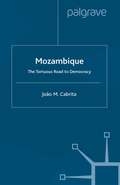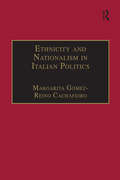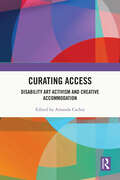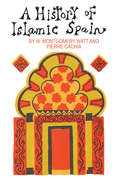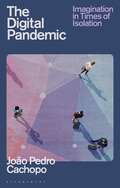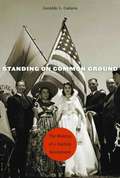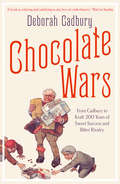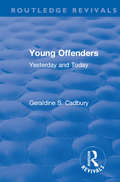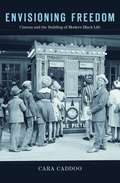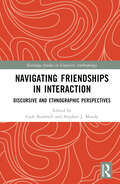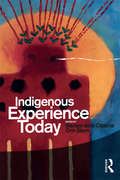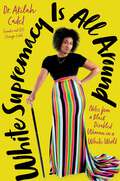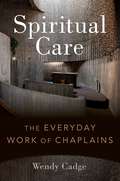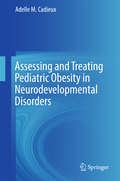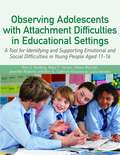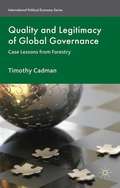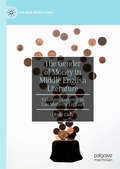- Table View
- List View
Mozambique: The Tortuous Road to Democracy
by J. CabritaMozambique's civil war was inevitable given the tradition of conflict that has always characterized Frelimo, first as an independence movement, and then as a ruling party. Without disregarding the role played by both Rhodesia and South Africa in the war - in fact providing new and detailed information about it - Cabrita guides the reader through Frelimo's early days and gives a clear understanding of the pattern of internal dissent, persecution and physical elimination of members and opponents that remained the organization's hallmark.
Ethnicity and Nationalism in Italian Politics: Inventing the Padania: Lega Nord and the Northern Question (Research in Migration and Ethnic Relations Series)
by Margarita Gómez-Reino CachafeiroEmploying primary sources and interviews with protagonists of the rebellion of the Italian North, this book explores the invention of the Padanian nation and the construction of identity politics in Northern Italy. It reveals for the first time the connection between the ethnic wave in European party politics in the 1970s and the rise of a new radical right nationalism in the 1990s. The author highlights the way in which the discourse of national minorities was instrumental in the rise of a new political agenda that links territory, identity and cultural rights to create new boundaries of exclusion. In addition to clarifying the connection between the new nationalism and racism by demonstrating how cultural distinctiveness is constructed in contemporary European politics, this unique book also explores the dynamics of new party mobilization and the symbolic resources of nationalist rhetoric. This book presents for the first time data on political participation - both party elites and members - and the real dimension of the party organization.
Ethnicity and Nationalism in Italian Politics: Inventing the Padania: Lega Nord and the Northern Question (Research in Migration and Ethnic Relations Series)
by Margarita Gómez-Reino CachafeiroEmploying primary sources and interviews with protagonists of the rebellion of the Italian North, this book explores the invention of the Padanian nation and the construction of identity politics in Northern Italy. It reveals for the first time the connection between the ethnic wave in European party politics in the 1970s and the rise of a new radical right nationalism in the 1990s. The author highlights the way in which the discourse of national minorities was instrumental in the rise of a new political agenda that links territory, identity and cultural rights to create new boundaries of exclusion. In addition to clarifying the connection between the new nationalism and racism by demonstrating how cultural distinctiveness is constructed in contemporary European politics, this unique book also explores the dynamics of new party mobilization and the symbolic resources of nationalist rhetoric. This book presents for the first time data on political participation - both party elites and members - and the real dimension of the party organization.
Curating Access: Disability Art Activism and Creative Accommodation
by Amanda CachiaThis book is an interdisciplinary collection of twenty-four essays which critically examine contemporary exhibitions and artistic practices that focus on conceptual and creative aspects of access. Oftentimes exhibitions tack on access once the artwork has already been executed and ready to be installed in the museum or gallery. But what if the artists were to ponder access as an integral and critical part of their artwork? Can access be creative and experimental? And furthermore, can the curator also fold access into their practice, while working collaboratively with artists, considering it as a theoretical and practical generative force that seeks to make an exhibition more engaging for a wider diversity of audiences? This volume includes essays by a growing number of artists, curators, and scholars who ponder these ideas of ad-hoc, experimental and underground approaches within exhibition-making and artistic practices. It considers how, through these nascent exhibition models and art practices, enhanced experiences of access in the museum can be a shared responsibility amongst museum workers, curators, and artists, in tandem with the public, so that access becomes a zone of intellectual and creative "accommodation," rather than strictly a discourse on policy. The book provides innovative case studies which provide a template for how access might be implemented by individuals, artists, curators, museum administrators and educators given the growing need to offer as many modalities of access as possible within cultural institutions. This book shows that anyone can be a curator of access and demonstrates how to approach access in a way that goes beyond protocol and policy. It will thus be of interest to students and scholars engaged in the study of museums, art history and visual culture, disability, culture, and communication.
Curating Access: Disability Art Activism and Creative Accommodation
by Amanda CachiaThis book is an interdisciplinary collection of twenty-four essays which critically examine contemporary exhibitions and artistic practices that focus on conceptual and creative aspects of access. Oftentimes exhibitions tack on access once the artwork has already been executed and ready to be installed in the museum or gallery. But what if the artists were to ponder access as an integral and critical part of their artwork? Can access be creative and experimental? And furthermore, can the curator also fold access into their practice, while working collaboratively with artists, considering it as a theoretical and practical generative force that seeks to make an exhibition more engaging for a wider diversity of audiences? This volume includes essays by a growing number of artists, curators, and scholars who ponder these ideas of ad-hoc, experimental and underground approaches within exhibition-making and artistic practices. It considers how, through these nascent exhibition models and art practices, enhanced experiences of access in the museum can be a shared responsibility amongst museum workers, curators, and artists, in tandem with the public, so that access becomes a zone of intellectual and creative "accommodation," rather than strictly a discourse on policy. The book provides innovative case studies which provide a template for how access might be implemented by individuals, artists, curators, museum administrators and educators given the growing need to offer as many modalities of access as possible within cultural institutions. This book shows that anyone can be a curator of access and demonstrates how to approach access in a way that goes beyond protocol and policy. It will thus be of interest to students and scholars engaged in the study of museums, art history and visual culture, disability, culture, and communication.
A History of Islamic Spain
by Pierre CachiaThe period of Muslim occupation in Spain represents the only significant contact Islam and Europe was ever to have on European soil. In this important as well as fascinating study, Watt traces Islam's influence upon Spain and European civilization - from the collapse of the Visigoths in the eighth century to the fall of Granada in the fifteenth, and considers Spain's importance as a part of the Islamic empire. Particular attention is given to the golden period of economic and political stability achieved under the Umayyads. Without losing themselves in detail and without sacrificing complexity, the authors discuss the political, social, and economic continuity in Islamic Spain, or al-Andalus, in light of its cultural and intellectual effects upon the rest of Europe. Medieval Christianity, Watt points out, found models of scholarship in the Islamic philosophers and adapted the idea of holy war to its own purposes while the final reunification of Spain under the aegis of the Reconquista played a significant role in bringing Europe out of the Middle Ages. A survey essential to anyone seeking a more complete knowledge of European or Islamic history, the volume also includes sections on literature and philology by Pierre Cachia. This series of Islamic surveys is designed to give the educated reader something more than can be found in the usual popular books. Each work undertakes to survey a special part of the field, and to show the present stage of scholarship here. Where there is a clear picture this will be given; but where there are gaps, obscurities and differences of opinion, these will also be indicated. Full and annotated bibliographies will afford guidance to those who want to pursue their studies further. There will also be some account of the nature and extent of the source material. The series is addressed in the first place to the educated reader, with little or no previous knowledge of the subject; its character is such that it should be of value also to
A History of Islamic Spain (Islamic Surveys Ser.)
by Pierre CachiaThe period of Muslim occupation in Spain represents the only significant contact Islam and Europe was ever to have on European soil. In this important as well as fascinating study, Watt traces Islam's influence upon Spain and European civilization - from the collapse of the Visigoths in the eighth century to the fall of Granada in the fifteenth, and considers Spain's importance as a part of the Islamic empire. Particular attention is given to the golden period of economic and political stability achieved under the Umayyads. Without losing themselves in detail and without sacrificing complexity, the authors discuss the political, social, and economic continuity in Islamic Spain, or al-Andalus, in light of its cultural and intellectual effects upon the rest of Europe. Medieval Christianity, Watt points out, found models of scholarship in the Islamic philosophers and adapted the idea of holy war to its own purposes while the final reunification of Spain under the aegis of the Reconquista played a significant role in bringing Europe out of the Middle Ages. A survey essential to anyone seeking a more complete knowledge of European or Islamic history, the volume also includes sections on literature and philology by Pierre Cachia. This series of Islamic surveys is designed to give the educated reader something more than can be found in the usual popular books. Each work undertakes to survey a special part of the field, and to show the present stage of scholarship here. Where there is a clear picture this will be given; but where there are gaps, obscurities and differences of opinion, these will also be indicated. Full and annotated bibliographies will afford guidance to those who want to pursue their studies further. There will also be some account of the nature and extent of the source material. The series is addressed in the first place to the educated reader, with little or no previous knowledge of the subject; its character is such that it should be of value also to
The Digital Pandemic: Imagination in Times of Isolation
by João Pedro CachopoA refreshing approach to the dominance of technology in our contemporary lives, The Digital Pandemic, translated from Portuguese, poses fundamental questions about love, fear, connectedness, proximity, imagination and consciousness.Arguing that the pandemic has ushered in a civilizational digital shock, João Pedro Cachopo charts new channels of relatedness and communication between people through digital technologies for the foreseeable future. The transformation of human experience that began in 2020 creates a break in our sociality that Cachopo pinpoints through key themes of love, travel, study, community and art.In contrast to the growing philosophical literature on the pandemic, this bold theoretical work does not prophesy the fall of capitalism or the end of personal freedom and relationships. Instead, this book carefully investigates the advanced technology that is increasingly inextricable from our lives, using an alternative approach that avoids pessimism, while remaining alert to the risks and threats of the digital age. It opens up the possibility of fostering global solidarity and consciousness beyond physical borders in the 21st century.
The Digital Pandemic: Imagination in Times of Isolation
by João Pedro CachopoA refreshing approach to the dominance of technology in our contemporary lives, The Digital Pandemic, translated from Portuguese, poses fundamental questions about love, fear, connectedness, proximity, imagination and consciousness.Arguing that the pandemic has ushered in a civilizational digital shock, João Pedro Cachopo charts new channels of relatedness and communication between people through digital technologies for the foreseeable future. The transformation of human experience that began in 2020 creates a break in our sociality that Cachopo pinpoints through key themes of love, travel, study, community and art.In contrast to the growing philosophical literature on the pandemic, this bold theoretical work does not prophesy the fall of capitalism or the end of personal freedom and relationships. Instead, this book carefully investigates the advanced technology that is increasingly inextricable from our lives, using an alternative approach that avoids pessimism, while remaining alert to the risks and threats of the digital age. It opens up the possibility of fostering global solidarity and consciousness beyond physical borders in the 21st century.
Standing on Common Ground: The Making Of A Sunbelt Borderland
by Geraldo L. CadavaStanding on Common Ground locates the roots of today's debates over border enforcement in the Sunbelt's pan-ethnic and transnational history, as cross-border ties in the 1940s among entrepreneurs and politicians, and a flourishing cultural traffic among tourists and students, gave way to economic instability and illegal labor migration.
Standing on Common Ground: The Making Of A Sunbelt Borderland
by Geraldo L. CadavaStanding on Common Ground locates the roots of today's debates over border enforcement in the Sunbelt's pan-ethnic and transnational history, as cross-border ties in the 1940s among entrepreneurs and politicians, and a flourishing cultural traffic among tourists and students, gave way to economic instability and illegal labor migration.
Chocolate Wars: From Cadbury To Kraft: 200 Years Of Sweet Success And Bitter Rivalry
by Deborah CadburyThe delicious true story of the early chocolate pioneers by the award-winning writer, and direct descendant of the famous chocolate dynasty, Deborah Cadbury
Revival: Yesterday and Today (Routledge Revivals)
by Geraldine S. CadburyThis unusual book tells vividly the story of children who have broken the law and their treatment from the time of King Athelstan to present day. With few exceptions, they suffered for centuries the same harsh treatment as older men and women, and it was only gradually that the terrible conditions in the prisons in this and other countries improved The early experiments in wiser treatment are graphically described and the efficacy of modern reformative measures is clearly demonstrated Legislation affecting young offenders is explained and the book should prove most valuable to all those who have responsibility for dealing with difficult children
Revival: Yesterday and Today (Routledge Revivals)
by Geraldine S. CadburyThis unusual book tells vividly the story of children who have broken the law and their treatment from the time of King Athelstan to present day. With few exceptions, they suffered for centuries the same harsh treatment as older men and women, and it was only gradually that the terrible conditions in the prisons in this and other countries improved The early experiments in wiser treatment are graphically described and the efficacy of modern reformative measures is clearly demonstrated Legislation affecting young offenders is explained and the book should prove most valuable to all those who have responsibility for dealing with difficult children
Envisioning Freedom: Cinema and the Building of Modern Black Life
by Cara CaddooIn Cara Caddoo’s perspective-changing study, African Americans emerge as pioneers of cinema from the 1890s to 1920s. But as it gained popularity, black cinema also became controversial. Black leaders demanded self-representation and an end to cinematic mischaracterizations which, they charged, violated the civil rights of African Americans.
Envisioning Freedom: Cinema and the Building of Modern Black Life
by Cara CaddooIn Cara Caddoo’s perspective-changing study, African Americans emerge as pioneers of cinema from the 1890s to 1920s. But as it gained popularity, black cinema also became controversial. Black leaders demanded self-representation and an end to cinematic mischaracterizations which, they charged, violated the civil rights of African Americans.
Navigating Friendships in Interaction: Discursive and Ethnographic Perspectives (Routledge Studies in Linguistic Anthropology)
by Cade Bushnell and Stephen J. MoodyBushnell and Moody present a rich investigation into the navigation of friendships, adopting discursive and ethnographic perspectives to examine Japanese, Chinese, Korean, and English interactional data. Since the definition of friendship is hard to pin down, most sociocultural anthropologists have tended to focus on issues of kinship and descent, while leaving friendship as a residual or interstitial issue. However, this book puts friendship as the central focus and offers unique perspectives from the participants themselves. The interactional work implicated in the accomplishment of making and being friends, and the trials and tribulations of friendship, are both explored through the many detailed analyses showing how the participants navigate the calm and rough waters of friendship in and through their everyday interactions. Researchers, undergraduates, and postgraduate students in the fields of conversation analysis, pragmatics, and other social sciences will benefit from the real-life examples in the book as well as the analysis.
Indigenous Experience Today (Wenner-Gren International Symposium Series)
by Marisol De La Cadena Orin StarnA century ago, the idea of indigenous people as an active force in the contemporary world was unthinkable. It was assumed that native societies everywhere would be swept away by the forward march of the West and its own peculiar brand of progress and civilization. Nothing could be further from the truth. Indigenous social movements wield new power, and groups as diverse as Australian Aborigines, Ecuadorian Quichuas, and New Zealand Maoris, have found their own distinctive and assertive ways of living in the present world. Indigenous Experience Today draws together essays by prominent scholars in anthropology and other fields examining the varied face of indigenous politics in Bolivia, Botswana, Canada, Chile, China, Indonesia, and the United States, amongst others. The book challenges accepted notions of indigeneity as it examines the transnational dynamics of contemporary native culture and politics around the world.
White Supremacy Is All Around: Notes from a Black Disabled Woman in a White World
by Akilah CadetFounder and CEO of consulting firm Change Cadet Dr. Akilah Cadet shares a powerful, incisive look at where we are in the fight to dismantle white supremacy—and what we urgently need to do next.This is the story of how I became an unapologetic Black disabled woman in a white world. This book is for people who look and live structurally like me to be valued, seen, heard and perhaps some advice on how to navigate life amongst white supremacy. This book is also for white people who have been &“doing the work&” since the murder of George Floyd to read my story and be able to clearly see systemic oppression, racism, and ableism. There are books sharing the historical context of white supremacy, providing tips on how to be an ally or anti-racist, and firsthand experiences from Black Indigenous People of Color (BIPOC) which are important. I push the conversation that leads to real change through my story. This book is for the Black woman who is looking to been seen and soft in shared lived experience. It is for the white person who is immersing themselves in the community they want to advocate for. It is for anyone who understands that learning and unlearning is lifelong. White Supremacy Is All Around arrives as the U.S.&’s ongoing racial reckoning has left readers searching for voices they can trust. BIPOC, disabled people, and other intentionally ignored Americans want to feel heard and empowered; organization leaders and allies invested in dismantling white supremacy want a framework for how best to contribute. Dr. Akilah Cadet speaks to all these needs, drawing from her life experiences and work helping leading brands build inclusive and equitable cultures to offer an informed perspective that prioritizes belonging. In a series of personal stories told with her trademark candor and wit, Dr. Cadet explores the long-term work required to combat structural oppression from her unique vantage point as a Black disabled woman. She tackles everything: from the 2020 &“summer of allyship&” and depression caused by workplace discrimination to navigating disability and building a consulting business, all with a little inspo from Beyoncé. A powerful call for true accompliceship for non-Black people, and a way for Black people to see and celebrate themselves, White Supremacy Is All Around ushers in a new voice that is timely, urgent, and essential—and a vision we all need now.
Spiritual Care: The Everyday Work of Chaplains
by Wendy CadgeChaplains are America's hidden religious leaders. Required in the military, federal prisons, and Veterans Administration Medical Centers, chaplains also work in two-thirds of hospitals, most hospices, many institutions of higher education, and a growing range of other settings. The chaplains of the U.S. House and Senate regularly engage with national leaders through public prayer and private conversation. Chaplains have been present at national protests, including the racial justice protests that took place across the country in 2020. A national survey conducted in the United States in 2019 found that 21% of the Americans public had contact with a chaplain in the prior two years. Contact with chaplains likely increased with the COVID-19 pandemic, which thrust chaplains into the spotlight, as they cared for patients, family members, and exhausted and traumatized medical staff fighting the pandemic in real time. Wendy Cadge steps back to ask who chaplains are, what they do across the United States, how that work is connected to the settings where they do it, and how they have responded to and helped to shape contemporary shifts in the American religious landscape. She focuses on Boston as a case study to show how chaplains have been, and remain, an important part of institutional religious ecologies, both locally and nationally. She has combed through the archives of major Boston institutions including the city government, police and fire department, hospitals, universities, rest and rehabilitation centers, the Catholic church, and several Protestant denominations, as well as the Boston Globe, to chart the work of chaplains historically. Cadge also interviewed over one hundred chaplains who work in greater Boston and shadowed them whenever possible, going on board container ships, walking through homeless shelters, and attending religious services at local prisons. The result is a rich study of a little-noticed but essential group of religious leaders.
Spiritual Care: The Everyday Work of Chaplains
by Wendy CadgeChaplains are America's hidden religious leaders. Required in the military, federal prisons, and Veterans Administration Medical Centers, chaplains also work in two-thirds of hospitals, most hospices, many institutions of higher education, and a growing range of other settings. The chaplains of the U.S. House and Senate regularly engage with national leaders through public prayer and private conversation. Chaplains have been present at national protests, including the racial justice protests that took place across the country in 2020. A national survey conducted in the United States in 2019 found that 21% of the Americans public had contact with a chaplain in the prior two years. Contact with chaplains likely increased with the COVID-19 pandemic, which thrust chaplains into the spotlight, as they cared for patients, family members, and exhausted and traumatized medical staff fighting the pandemic in real time. Wendy Cadge steps back to ask who chaplains are, what they do across the United States, how that work is connected to the settings where they do it, and how they have responded to and helped to shape contemporary shifts in the American religious landscape. She focuses on Boston as a case study to show how chaplains have been, and remain, an important part of institutional religious ecologies, both locally and nationally. She has combed through the archives of major Boston institutions including the city government, police and fire department, hospitals, universities, rest and rehabilitation centers, the Catholic church, and several Protestant denominations, as well as the Boston Globe, to chart the work of chaplains historically. Cadge also interviewed over one hundred chaplains who work in greater Boston and shadowed them whenever possible, going on board container ships, walking through homeless shelters, and attending religious services at local prisons. The result is a rich study of a little-noticed but essential group of religious leaders.
Assessing and Treating Pediatric Obesity in Neurodevelopmental Disorders
by Adelle M. CadieuxThis book reviews strategies for assessing and treating pediatric obesity in children with neurodevelopmental disorders (ND). It synthesizes empirical findings and clinical strategies to offer the latest knowledge in key areas, including risk factors, physical activity, nutrition, treatment planning, goal-setting, and engagement with patients. A four-stage treatment model presents clinical guidance in triaging treatment and tailoring interventions to children’s changing medical, behavioral, emotional, and cognitive needs. The book complements current pediatric ND literature by presenting clear guidelines for integrating treatment for obesity into existing treatment of these young patients. Topics featured in this book include: The effect of neurodevelopmental disorders on the assessment of obesity in children.The impact of developmental delays on physical activities and health behaviors.Strategies for promoting weight management goals in pediatric ND.Suggestions on how to engage and support families and caregivers.The role of prevention in weight management within pediatric ND. Assessing and Treating Pediatric Obesity in Neurodevelopmental Disorders is a must-have resource for clinicians, scientist-practitioners, and related professionals as well as researchers, professors, and graduate students in clinical child and school psychology, public health, social work, pediatrics, occupational therapy, and nutrition.
Observing Adolescents with Attachment Difficulties in Educational Settings: A Tool for Identifying and Supporting Emotional and Social Difficulties in Young People Aged 11-16 (PDF)
by Ann Cadman Helen Worrall Jennifer Roberts Kim Golding Louise Bombèr Mary TurnerThis easy-to-use tool provides an observation checklist which enables staff to identify behavioural patterns in children with social and emotional difficulties, analyse the underlying emotional difficulties and establish what kind of help and support the children need. Behavioural responses are categorised within clearly outlined topics, including: * behaviour and relationship with peers * attachment behaviours * emotional state in the classroom * attitude to attendance Checklists and diagrams identify different 'styles' of relating, to help school staff to respond appropriately to the individual needs of each child. A range of handouts include activities designed to provide emotional support, to focus and regulate behaviour and enable the child to develop important social and emotional skills. Suitable for use with children aged 11+, this tool will be an invaluable resource for teachers, teaching assistants, learning support staff, school counsellors and educational psychologists.
Quality and Legitimacy of Global Governance: Case Lessons from Forestry (International Political Economy Series)
by T. CadmanAs the international community struggles with major issues such as deforestation, it is increasingly turning to sustainable development and market-based mechanisms to tackle environmental problems. Focusing on forestry, this book investigates the legitimacy of global forums and evaluates the quality of global governance in the current era.
The Gender of Money in Middle English Literature: Value and Economy in Late Medieval England (The New Middle Ages)
by Diane CadyThe Gender of Money in Middle English Literature: Value and Economy in Late Medieval England explores the vital and under-examined role that gender plays in the conceptualization of money and value in a period that precedes and shapes what we now recognize as the discipline of political economy. Through readings of a range of late Middle English texts, this book demonstrates the ways in which gender ideology provided a vocabulary for articulating fears and fantasies about money and value in the late Middle Ages. These ideas inform beliefs about money and value in the West, particularly in realms that are often seen as outside the sphere of economy, such as friendship, love and poetry. Exploring the gender of money helps us to better understand late medieval notions of economy, and to recognize the ways in which gender ideology continues to haunt our understanding of money and value, albeit often in occluded ways.
